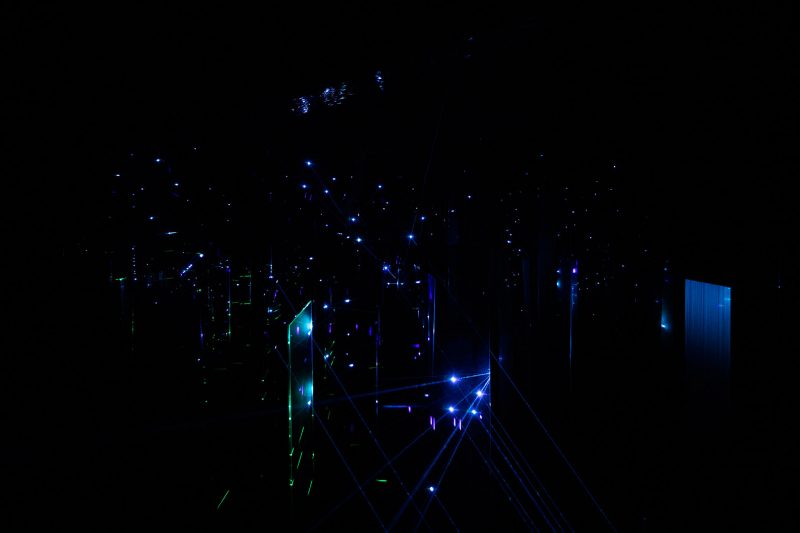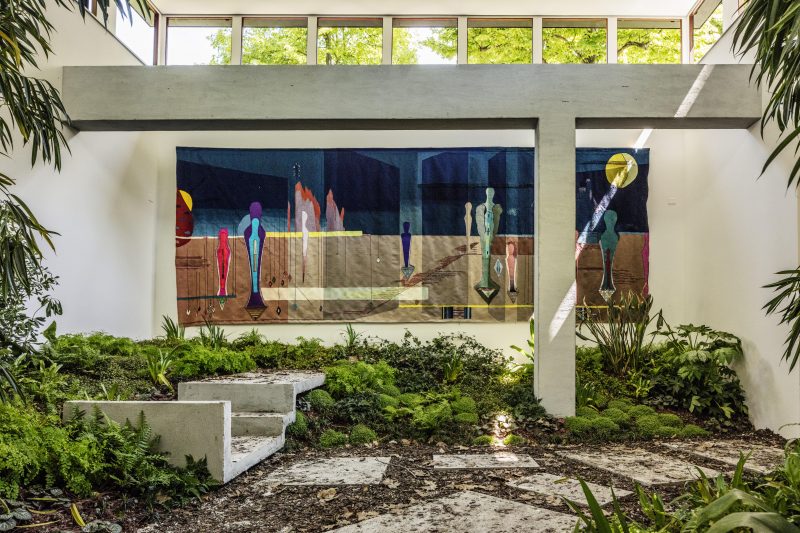One of the most surprising and critically divisive works in the 2017 Venice Biennale was Kirstine Roepstorff’s project Influenza for the Danish Pavilion. Primarily known for her collage-based approach, Roepstorff made a significant artistic departure with Influenza. The first and main part of the work required the audience to submit to a fifteen-minute-long “theater of glowing darkness,” an abstract panoply of voices and dim specters of illumination emerging through the pitch blackness. Afterward, the audience was released into the outdoor garden surrounding the pavilion, where the artist had planted lemon trees, fans, lilies, tobacco plants, roses, elephant ears, ivy, sage, thyme, chamomile, and dots-in-the-air. The third part consisted of an abstract tapestry hung from an exposed wall in the garden, and the fourth part, the most hidden of all, was an invisible force of collaboration woven into the project.
On a sunny afternoon in late September, I sat in the garden with Roepstorff to discuss the origins of Influenza.
—Travis Jeppesen

Influenza
TRAVIS JEPPESEN: Some people might consider Influenza to be three separate works.
KIRSTINE ROEPSTORFF: To me, it’s really one piece, but in sections. I like to see the whole setting as sort of a mind-set. A way to negotiate with our mind and our consciousness. When I started, the first word I got for this show, before I knew anything at all, was influenza. And I was like, huh? What is this “influenza” about?
TJ: It just popped into your mind.
KR: Very visually! Big capital letters in front of my eyes. A few weeks before I got the invitation for Venice. It’s a very interesting word. Beautiful, when you read it. It’s harsh, sticky, nasty, but very dynamic in a weird way. So when I received the invitation, it popped up more often, and in conjunction with Venice, so I somehow knew they had something to do with each other.
But I was trying to understand what this “influenza” is about. I quite soon realized it’s not a physical influenza; it’s a buried weakness that has less to do with the individual and more with the group—the collective—society. At first, I thought it had to do with too much light… Is there too much sun here for you?
TJ: I can turn away. Turn away from the light—like visitors do when they enter your pavilion!

KR: Well, I thought it was interesting because we do live in a very light-exposed society. We want to be in the light; we see the light. It’s dynamic; it’s growth. With all this social media and self-exposure, we put ourselves into the light in order to be seen and gain a form.
TJ: Then there’s also excess light as an environmental concern: light pollution, for instance, which prevents us from seeing the night sky.
KR: At the tail end of it, I realized that Influenza is not about too much light—it’s about too little darkness. What is the darkness? Is it when you turn out the light? Is it the Dark Ages of history? Is it our unconscious? Things we don’t want to confront or reveal? Is it our hidden structures, our rest, our retreat? Somehow it’s so hard for us to add those elements into our real lives. Everyone knows that, one to three months without work, we start to get nervous and neurotic; we lose our sense of self-value. Because you are left with yourself. So I realized that the darkness is the retreat. We consciously know it is needed, but practically, we cannot accept having to adopt it into our lives.
TJ: We resist the darkness.
KR: We resist it. So, as you can hear in the dialogue in the darkness, it really is about resistance to that which nurtures us.
TJ: Did you settle on a sound-based piece to elicit a sense of formlessness, of detachment from the body?
KR: Everything that had to do with the pavilion had to be rooted in a dissolution of form. In the Venice Biennale, everyone is looking for forms. Everyone wants to be in the light. It is the absolute light exposure. And I resist. I know this is what we like it to be about, but I also know that deep down, profoundly, that’s not what it’s about. Because there is no exposure without first having the nurturing. That nurturing is important, because what happens to us is what makes us grow.
So the theater then floats out into the garden [the second part of the pavilion and of Influenza], where the garden is the very quiet theater: what is going on under the earth. You need a seed under the earth before you can make a seed grow; you need an unconscious blob before you can form a sentence… All of these things rely upon the darkness. Once things reach the light, they are nearly dying; they are already beginning to de-texturize.
TJ: I’m interested in how you literalize this process, of leaving the darkness and entering into the light of the garden. You’ve altered the whole architecture of the pavilion by planting this garden that extends from it. So Influenza becomes, among other things, a site-specific work.
KR: I didn’t want to leave the old structure—this building—as a ruin. Rather, when things renew themselves, they use the old structure to give shape to the new path. It’s there for the new structure to grow upon. The whole pavilion is for me a suggestion: hey, let’s look at the darkness; let’s look at what does not have a form; let’s accept that things are changing and see what comes up that might guide us through the future—but let’s do it together. Therefore, it is a collective influenza—both symptom and cure.
TJ: When did you think of adding the tapestry? That forms the third and final component of the work, if I’m correct.
KR: It’s actually the third out of the fourth. The fourth is very hidden. I will tell you about it in a minute.
The tapestry is really a doorknob to access. It could easily not be there. But it is sort of an image of everything that’s going on in the pavilion. A one-line statement.
TJ: It feels like a spiritual, static visual projection of what’s elicited in the darkness of that theater. Because there are no clear images except for the ones that are created in your head from the experience of sitting in the darkness.
KR: The tapestry is very literal and horizontal. You have what’s happening above the line and what’s happening below the line. Below the line, you have all the seeds. The seeds are sort of dormant: some are sleeping, some have begun to sprout upward. But there is still this twilight landscape, where the sun is either rising or setting: you have the moon that is still there… It’s somehow…
TJ: …an illustration of this notion of growth.
KR: In a way. The concrete structures are all moist, like sweat. There is a porousness. Our skin is kind of a surface, but it’s not holding much in or out. You can still get penetrated by bacteria, you still sweat stuff out. The seemingness of surface is really what gets repeated over and over here.
TJ: What is the fourth part that I’ve been missing?
KR: That was probably the biggest task. It hasn’t succeeded yet. It doesn’t need to succeed now. It’s all about process. The process is really the goal, in a way.
So I had a to-do list. Most often, as the artist selected for the Venice Biennale, you have a curator. So they asked me to choose one. I had difficulty with this, because for me, it’s not a single person project, it’s a communal project. I needed a sounding board so that it wouldn’t be about a single artist’s individual relationship with the darkness—for me, that wasn’t the point. Because we’re all afflicted with the influenza. Let’s see how we can do it together.
I asked four curators to participate in a one-year school of darkness. I was the conductor, in a way, because obviously it was my idea. So when we worked, we worked as a group. I told them, “I know that all of you guys are really smart and have done tons of shows, but in this workshop, I take away all your normal tasks and throw them out, and you’re all to act as artists, as individuals. You’re like sponges. And now, we set out into the darkness together and see how it comes out.”
TJ: How did that work on a practical level? Did they actually contribute to the writing of the text?
KR: No, not on that text. The text in the theater is my text. We had workshops throughout the year. They didn’t all know each other, so we got to know one another. It was really important to me that we share experiences. We had to get to the point where they would throw off their autopilots. We had really intense two-day workshops. Part of it was discussing what is darkness, and part of it was physically experiencing darkness on a sensorial level. We went swimming in the ocean at night. We did meditation. We submerged ourselves in sensory deprivation tanks. We went to Berlin to eat in the darkness at this restaurant run by the blind. In the end, they were asked to write a text. I told them, “You can’t write about me. You can’t write about the project as such. It’s completely forbidden to quote. I really want a text that’s based on your experience in the darkness.”




